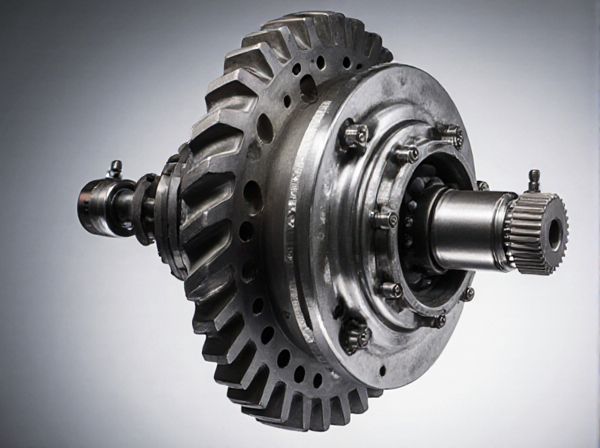
Photo illustration: Clutch-Type Differential vs Gear-Type Differential
Clutch-type differentials offer improved traction by allowing limited slip between wheels, making them ideal for performance and off-road vehicles where variable power distribution is crucial. Gear-type differentials, such as open or limited-slip differentials, rely on gears to transfer torque evenly, providing reliability and smooth operation under normal driving conditions. Choosing between these depends on your driving needs, with clutch-type differentials excelling in aggressive, high-torque scenarios and gear-type serving well for everyday use.
Table of Comparison
| Feature | Clutch-Type Differential | Gear-Type Differential |
|---|---|---|
| Mechanism | Uses friction clutches to control wheel torque | Utilizes gears (planetary or bevel) to distribute torque |
| Torque Distribution | Adjustable via clutch engagement, offers variable torque transfer | Fixed or limited torque transfer depending on design |
| Performance | Improves traction under slip conditions | Robust with consistent power delivery |
| Maintenance | Requires clutch replacement and periodic adjustments | Low maintenance; gear wear is slower but requires lubrication |
| Cost | Generally higher due to complex clutch components | Typically lower, simpler gear construction |
| Common Applications | Performance cars, off-road vehicles | Standard road vehicles, heavy-duty applications |
| Advantages | Better traction control, adaptable to conditions | Durable, reliable, simple design |
| Disadvantages | Higher cost, more complex maintenance | Less adaptable to varying traction scenarios |
Introduction to Automotive Differentials
Clutch-type differentials use friction plates to distribute torque between wheels, allowing for controlled slip during cornering, which enhances traction on uneven surfaces. Gear-type differentials, such as open or limited-slip differentials, rely on mechanical gears to split torque evenly or proportionally, providing consistent power delivery and improved stability. Both systems are integral to vehicle drivetrains, influencing handling characteristics and performance in various driving conditions.
What is a Clutch-Type Differential?
A clutch-type differential uses friction plates and a set of clutch packs to distribute torque between wheels, providing improved traction during cornering or uneven road conditions. This design allows controlled slip between wheels by engaging the clutches based on torque transfer needs, reducing wheel spin and enhancing stability. Commonly found in high-performance and off-road vehicles, it offers smoother operation compared to traditional gear-type differentials.
How Gear-Type Differentials Work
Gear-type differentials utilize a set of planetary gears to distribute torque between the wheels, allowing for smooth power transfer and improved traction on varying road surfaces. These differentials employ side gears connected to the axle shafts and pinion gears that rotate around the differential case, enabling wheels to rotate at different speeds during turns. Their mechanical design provides durability and consistent performance in high-torque applications, making them ideal for off-road and performance vehicles.
Key Design Differences
Clutch-type differentials use friction plates to distribute torque between wheels, allowing for smooth power transfer and better traction under varying grip conditions. Gear-type differentials, such as open or locking differentials, rely on gear mechanisms like bevel or planetary gears to split torque, providing consistent power distribution but potentially less adaptability on slippery surfaces. The key design difference lies in the clutch assembly's ability to modulate torque versus the fixed gear engagement in gear-type systems, impacting performance in high-torque and off-road applications.
Performance Comparison: Clutch vs Gear-Type
Clutch-type differentials provide superior torque distribution control and enhanced traction during variable driving conditions by modulating clutch engagement, ideal for high-performance street and off-road vehicles. Gear-type differentials, such as helical or planetary designs, offer consistent and low-maintenance operation with efficient torque split but may lack the adaptive grip benefits of clutch systems under dynamic load changes. Performance metrics indicate clutch-type differentials excel in responsive power transfer and traction adaptability, while gear-type differentials prioritize durability and smooth, predictable handling.
Traction Capabilities and Applications
Clutch-type differentials offer enhanced traction by allowing variable torque distribution between wheels, making them ideal for high-performance and off-road vehicles needing responsive power shifts on uneven terrain. Gear-type differentials, including limited-slip variants, provide consistent torque transfer through mechanical gears, excelling in durability and reliability for heavy-duty trucks and industrial machinery. Both differential types optimize traction, but clutch-type differentials prioritize adaptability in dynamic driving conditions, while gear-type differentials emphasize robustness and maintenance-free operation.
Durability and Maintenance Requirements
Clutch-type differentials rely on friction-based clutch plates that require periodic inspection and replacement to maintain optimal performance, making their maintenance more frequent but relatively straightforward. Gear-type differentials use solid gears that are inherently durable and typically demand less frequent maintenance, though they require precise lubrication to prevent wear and ensure longevity. Both types offer robust durability, but gear-type differentials generally boast longer service intervals and lower maintenance needs compared to clutch-type systems.
Cost Analysis and Value Proposition
Clutch-type differentials typically incur higher maintenance costs due to wear on friction plates, but offer superior traction and smooth engagement, enhancing vehicle control under varied driving conditions. Gear-type differentials, such as limited-slip and locking variants, generally present lower initial costs and greater durability with fewer moving parts, making them cost-effective for off-road and heavy-duty applications. The value proposition hinges on balancing upfront investment, long-term reliability, and specific use cases, with clutch-type favoring performance-oriented vehicles and gear-type suited for rugged, low-maintenance demands.
Choosing the Right Differential for Your Vehicle
Selecting the right differential for your vehicle hinges on understanding the distinct advantages of clutch-type and gear-type differentials. Clutch-type differentials offer adjustable traction control and better handling in varying road conditions by distributing torque selectively, making them ideal for performance and off-road vehicles. Gear-type differentials, known for durability and consistent torque distribution, are preferable for heavy-duty and all-terrain vehicles where reliability and low maintenance are critical.
Summary: Clutch-Type vs Gear-Type Differential
Clutch-type differentials use friction plates to allow limited slip between wheels, providing smoother operation and better traction under varying conditions. Gear-type differentials rely on a set of gears to distribute torque evenly, offering durability and consistent performance in high-stress applications. Clutch-type systems excel in flexibility and responsiveness, while gear-type systems are favored for their reliability and low maintenance.
 caratoz.com
caratoz.com